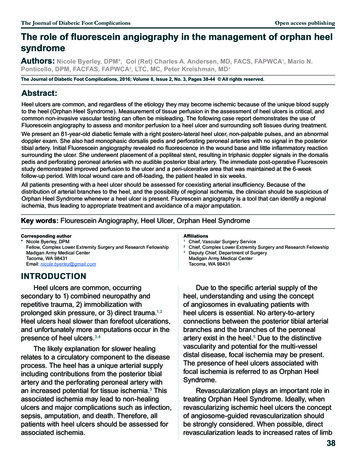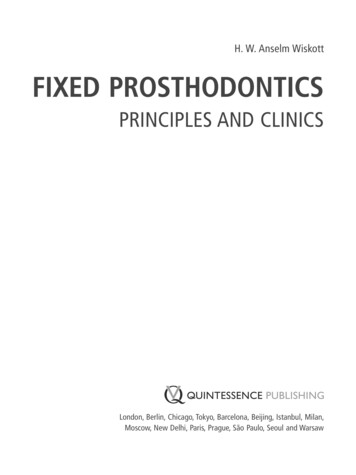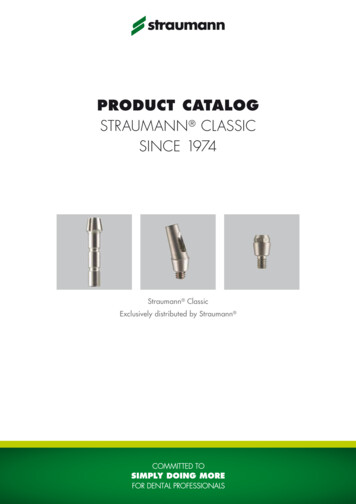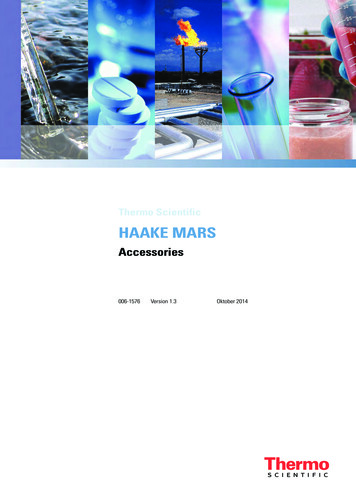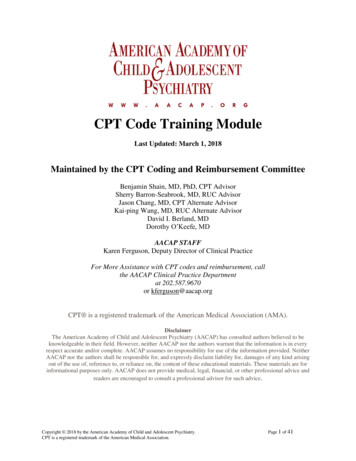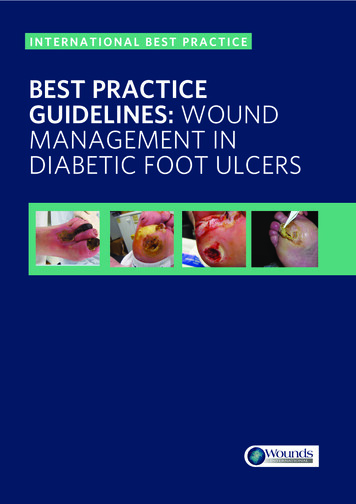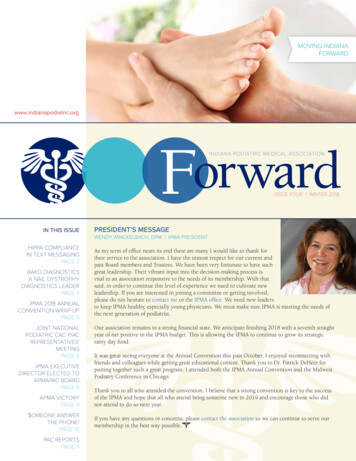
Transcription
Describe the VA Amputation System of Care andwhy it was developedIdentify and describe the phases of rehabilitationcare in the Clinical Practice Guideline for theRehabilitation of Lower Limb AmputationDescribe evidenced-based prosthetic andamputation rehabilitation outcomesUnderstand the importance of good workingrelationship between a physical therapist andProsthetistIdentify appropriate fit of lower extremity prosthesesDescribe how the information gained during thelecture can be applied to your clinical practice
Each major military operation hasresulted in a new cohort of veteran’swith combat-related traumaticamputation: Civil War 70,000 WW1 4,403 WW2 14,912Korea 1,000Vietnam 5283Persian Gulf War 15OIF/OEF /OND 1643
DoD identified a need for the combat-injuredsoldier with major traumatic limb loss 1st Military Treatment Facility (MTF) for SoldierAmputees created at Walter Reed Hospital 2006 –VA collaborates with DoD to meet theneeds of these newly combat-injured vetsfrom OIF/OEF while also improving care to allvets with amputations due to medical issues
June 2008, Dept of VA Health SystemsCommittee approved the developmentof the ASoC and was implemented in FY2009.
Specialized expertise in amputation care Medical rehab, therapy, prosthetictechnology Multidisciplinary approachEnhance environment of care andensure consistency VISION - Be a world leader in providing lifelong amputation care
Regional Amputation Centers –RACs (7) Medical Director Amputation RehabilitationCoordinator Program Support Assistant RAC ProsthetistPolytrauma Amputation NetworkSites – PANS (18) Medical Director 0.5 Amputation RehabilitationCoordinator Program Support AssistantAmputation Clinic Teams – ACTs(108)Amputation Points of Contact APOCs (22)
PANS-Indianapolis Core Interdisciplinary Amputation Care Team(MD,Prosthetist/Orthotist, PT,OT, & Psychologist) Regularly scheduled Amputee Clinic Clinical Video Tele-amputee Clinics with RACs, ACTs, APOC,CBOCsAccredited Prosthetics Lab2016 CARF Amputation Specialty ProgramAccreditation - Inpatient and OutpatientPeer Visitation Program 2010VET PALS Research (2014)Data collection/ Outcomes Measures
Amputation DataRegistry / Repository Clinical PracticeGuideline followingUpper and Lower LimbAmputation
Structured document that provideshealth care practitioners withrecommendations for various relatedhealth outcomes: Postoperative painPhysical HealthFunctionPsychological support & Well-BeingPatient SatisfactionReintegrationHealthcare Utilization
Improve patient care by reducing variationin practice Systematizing best practices to achievebest outcomes
Adult patients with major lower extremityamputation (bilateral and unilateral)including through-hip, transfemoral,through-knee, transtibial, through-ankle,and partial foot.Cause may be traumatic or nontraumatic.
In 2014, 2.1 million people were living withlimb loss in the US. By 2050, that rate isexpected to double to 3.6 million Common Causes of LE Amputation Dysvascular (54%) – Peripheral Vascular Disease,Diabetes Mellitus, Chronic Venous Insufficiency Trauma (45%) Cancer and Malignancies (2%)(Us Dept Health and Human Services)
Diabetes affects 25.8 million people in theUS and 189 million people worldwide. By theyear 2025 the prevalence of diabetes isexpected to rise by 72% to 324 millionpeople globally. (American DiabetesAssociation) Up to 25% of those with diabetes willdevelop a foot ulcer.(Singh, Armstrong, Lipsky.J Amer Med Assoc 2005)
50% of all foot ulcers (wounds) willbecome infected, requiring hospitalizationand 1 in 5 will require an amputation. (Lavery,Armstrong, et al. Diabetes Care 2006) Other risk factors for amputation - PAD,LOPS, insulin dependence, impairedglucose control (Selby and Zhang, Diabetes Care1995)
Ambulatory mobility declined during the periodimmediately prior to surgery (premorbid) andremained low at 6 weeks post surgery. Onaverage, ambulation improved after surgery up toone year but did not return to premorbid levels (Czerniecki et al, Archives of Physical Med andRehab 2012)
Center for Disease Control and Preventionhave suggested the following: declines in diabetic amputation rates can beattributed to improvements in preventive care(appropriate footwear and patient education)PAVE – Prevention of Amputations in VeteransEverywhere LEAP - Lower Extremity Amputation Prevention Dept of Health and Human Services HealthResources and Services Administration http://www.hrsa.gov/hansensdisease/leap/
PAVE committee developed with VHAdirective and recommends:- Daily self inspections- Annual foot exams- High Risk Level Exams- Proper fitted shoes
The continuum of Amputee Care is dividedinto 5 Specific Phases: Pre-operative PhasePost-operative PhasePre-Prosthetic PhaseProsthetic Training PhaseLong Term Follow-up Phase
Decision to amputate Assess functional status and healthConsideration of amputation level, preop education, emotional support,physical therapy, nutritional support,pain management
Patient Education Learning Assessment- tailor education to meet needs ofthe individual with limb loss and identify barriers In-depth education to patient and family regarding theprocedure, various components of postoperative care,and rehabilitation activities that will occur Patients should be given appropriate advice andinformation on rehabilitation programs, prosthetic options,and possible outcomes with realistic rehabilitation goals(Esquenzai & Meier, 1996; Pandian & Kowalske, 1995).VA and Amputee Coalition Materials:1. The Next Step: The Rehabilitation Journey After LowerLimb Amputation2. The First Step: A Guide for Adapting to Limb Loss3. Side Step: A Guide to Preventing and ManagingDiabetes and its Complications
VA Amputation Education Support Group –AmputeeRehab Coordinator, Certified Peer Visitors, RehabPsychology, Amputee Clinic Evaluation with team Tobacco cessation, coping strategies, supportresources, contracture prevention, skin inspectionand care, desensitization techniques, shrinker/RRDcare, sound limb protection Review of the literature suggest that psychologicalintervention during the preoperative period isassociated with a less complicated postoperativeadjustment and grieving experience(Butler et al., 1992)
Initiate Appropriate RehabilitationInterventions Cardiovascular Fitness and Endurance Balance Strength/ROM –Assess for contractures Sensation Functional Rehab ( ADL, Transfers, Mobility,DME)
Time in hospital after amputation surgery,lasting 5-14 days. Hemodynamic stability, wound healing,prevention of complications Care of residual limb, patient education,physical therapy, occupational therapy,behavioral health PT’s-Baseline fxn
Post-op Dressings Soft Dressings vs. Rigid Dressing Soft Dressings: ACE Wrap, Shrinkers,Compression Pump Rigid Dressings: NWB rigid dressing, IPOP,Custom removable rigid dressing ( RRD),Prefabricated RRD, Prefabricated pneumaticIPOP Limited evidence is available regarding themanagement of residual limb volume andwhat there is focuses primarily on adults withtranstibial amputation in the earlypostoperative phase (Sanders et.al., 2011)
Residual Limb Management – encouragepatient participation Reduce post-op edema , begin shaping limbwith compression, promote incision healing RRD, Shrinker Protect residual limb from trauma RRD for BKA
Mirror therapy
Mirror therapy Protocol 15 minutes/day, 4 weeks 18 patients ; six in each of the following: Mirror therapygroup, covered mirror therapy group, mental imagerygroup Mirror therapy group (all 6) reported decreased phantomlimb pain; 1 in covered mirror and 2 in mental imageryreported decrease as well; 7 reported increase inphantom limb pain (Chan et al., 2007) 9/12 not assigned to mirror therapy group began 4 weekmirror therapy tx and all but 1 reported decrease in pain Repeated exposure to virtual images of mirror box may benecessary to improve likelihood of reducing phantom limbpain sxs
Focus on Residual Limb Management :volume reduction, pain control, contractureprevention Continued patient and family education Continued coping with loss of a limb Discharge planning from Acute Care
Patient avoids looking at or talking aboutamputation.Tearfulness (this doesn’t always indicatedepression but instead maybe more of anadjustment issue)Disparaging/negative remarks abouthim/herself (could be body image related)Change in behavior or mood/demeanorConsult to RehabilitationPsychologist/Behavioral Health Specialist
Not for Profit organization on limb loss,dedicated to enhancing the quality of lifefor amputees and their families, improvingpatient care and preventing limb loss Working to ensure that no amputee goesthrough their journey alone Peer Visitor Program inception 2003 tosupport wounded warriors at MilitaryHospitals
Partnered with the VA to implementCertified Peer Visitor Training Programsthroughout the ASoC in 2010 and PALS(Promoting Amputee Life Skills) programs in2012 Provide Educational materials ( online andhard copy) Limb Loss Education Days and NationalConference
Peer visitation of the amputee patientallows the patient to speak directly withanother amputee who has shared a similarexperience, which enables the patient toshare feelings and concerns about the lossof a limb (Fitzgerald 2000)
Rehabilitation Interventions independence with residual limb management,transfers, mobility, ADL, w/c and DME, HomeExercise Program, ROM, Strength, CV training
Begins with d/c from acute care up to 612 weeks after surgeryShift to rehabilitation focus - maximizingphysical function, social functionconcerning daily activities, and reintegration to home and communityGoals for independenceat w/c level withoutprosthesis
Acute Rehabilitation, SNF, Home with HHCor OP Therapy Multidisciplinary Assessment (Acute Rehaband SNF) Rehabilitation Interventions similar to Preand Post-op with focus on independencewith residual limb management, transfers,mobility, ADL, w/c and DME, Home ExerciseProgram, ROM
Rehabilitation Interventions Standardized Measures – Amputee Mobility Predictor (No Pro) Single Leg Standing Test (successful ability toperform this for 10 sec. has consistently been shown topredict better walking potential after lower limbamputation)(Sansam, et al 2012) Patient and Family education Issue Durable Medical Equipment
Good cognitive abilities, younger age,distal amputation level, and preoperativegood functional status predict physicalmobility with a prosthesis. “.elderly patients admitted for prosthetictraining to SNFs are also able to successfullyuse a prosthesis.” (van Eijk, et al Prosthetics andOrthotics International 2012)
Simple clinical assessments completedprior to prosthetic provision can be usedto predict mobility outcomeROM to detect contractures of hip/kneeSingle leg standing testAgeGenderLevel of amputationCognition(Sansam, et al 2012)
Functional outcomes after limb amputationcan be partially predicted based uponpreoperative clinical characteristics (Tayloret al., 2005) Patients with limited preoperative ambulatoryability, age 70, dementia, end-stage renaldisease, and advanced coronary artery diseaseperform poorly (not wearing prosthesis, death,failure to ambulate, dependent living status)(Taylor et al., 2005)
Is a Prosthesis Appropriate to ImproveFunctional Status and Meet RealisticPatient Goals?Candidacy determined by Interdisciplinaryteam based on pt’s characteristics, goals,functional status TT vs TF Considerations: motivation, cognition,contralateral limb, quality of life or self imagetransfers vs ambulationSingle leg standing -TF
Special Considerations Bilateral Transfemoral-Cardiac Stress test clearance-stubbies
Up to 6 months after healingBegins with temporary prosthesisRapid changes in residual limbvolumeIncludes- Gait training, prosthetictraining, various rehabilitationinterventions, and emphasis oncommunity reintegrationReturn to vocational andrecreational activities
Determine Prosthetic componentry Type of suspension/mechanism, foot/ankle,knee joint, socket, pylon Includes the following factors: residual limbcharacteristics, overall health, fitness,medical conditions, age, hand function,AMP NoPro/K level
Ambulating with a prosthesis results in anincrease in energy expenditure (Waters &Mulroy, 1999) Higher metabolic costs were found in patientswith higher anatomic levels of amputation (i.e.,transfemoral vs. transtibial), advanced age, orhistory of PVD (Huang et al., 1979). Do not expend more energy/minute then ablebodied persons, although energy required perunit distance is increased. Esquenazi & DiGiacomo (2001)emphasized thatregaining ambulation is a key to returningpatients to their previous lifestyles, roles,activities, and socialization.
Traumatic transtibial (TT) amputations use at least25% more energy during gait.Vascular TT amputation have at least a 40%increase in energy expenditure (Chow et al 2006;Nadollek et al 2002; Selles et al 2004)Traumatic transfemoral (TF) amputation use at least68% more energy during gait.Vascular TF amputation uses at least 100% moreenergy (Tokuno et al 2003; Sjödahl et al 2003)
Key Points Regarding PT Eval/TxGoal to optimize function and minimizeshort and long term problems. Must analyze functional use of prosthesis/normalize gait. Most can see asymmetry but PT’sjob is to find out what is going on and why. Must know the components of the prosthesisand how they work so patient can be taughthow to use the prosthesis to maximize functionand naturalize gait. TRUST!!! Must know when to contact Prosthetist- lucky tohave one on site! Don’t forget the sound limb side!
Components of prosthetic gait: steplength, step width, toe load, knee flexion,pelvic rotation and trunk rotation.Restoring biomechanicsto gait using a prosthesis(Advanced Rehab Therapy-Gailey et al)
Prosthetic Fitting – temporary socketRehab and Gait Training Goals should include: Prosthetic management (donning/doffingprosthesis, gel liners and socks) , residual limb care,appropriate fit Balance Gait –household and community distances Stairs Transfers ( including floor transfers) Functional Activities with prosthesis Don’t forget about contralateral limb
Home Exercise Program Weight Shifting all directions Single limb balance (stool stepping)Ball Rolling4 way hip resisted elastic kicksProne Press upsWheel Chair pushupsRepetitive sit - stand transfersStep ups
Patients return for check up on residuallimb, prosthetic fit, gait pattern,contralateral limb Limb loss prevention education Consideration of new prosthetictechnology – will it benefit pt ? Amputee Support Group - Monthly Sports and Recreation
No end point to this phase;recommended f/u at least yearlyLimb volume continues to change12-18 months after healingSocial reintegration and higher functionaltraining allowing them to becomeindependent from healthcare providerLifelong care of patient with focus onprevention of future amputations as wellas secondary complications
This model is often described in medicalrehabilitation Good evidence that states effective teammanagement improves rehab outcomes inpatients with other disabilities i.e stroke andSCI (Yagura et al., 2005) No randomized clinical trials assessing valueof interdisciplinary teams on functionaloutcomes from amputation rehabilitation
Importance driven by the need for evidencebased practice vs. providing services based ontradition or anecdoteWhy are they important? Evaluate the effectiveness of rehabilitation intervention,help justify our interventions, improve patient care, justifynew high tech components (improve function or quality oflife) Challenges Time constraint to implement Validation for one population in one situation (eg. BKAwith prosthesis 2 years after amputation
Categories Self report and performance-based Reliability and Validity Consistently measure what they say they are going tomeasure Measure what it is intended to measure Gold Standard Measure for Amputee/ProstheticRehab? No consensus regarding the “gold standard” despite amultitude of measures currently being used by researchers
When to use: Prior to and after receiving their prosthetic leg Beginning and end of rehab When a change of prosthetic componentry isneeded or recommended Long term tracking
Self Report Locomotor Capabilities Index 5Amputee Activity SurveyProsthetic Profile of AmputeeProsthetic EvaluationQuestionnaireSF-36 Health Status ProfileTrinity Amputation andProsthesis and ProsthesisExperience ScalesSickness Impact ProfileSocket Fit Comfort ScaleActivities –specific BalanceConfidence ScalePLUS-M (Prosthetics Limb UsersSurvey of Mobility)Performance Based Amputee Mobility Predictor(AMP)2 Minute Walk Test6 Minute Walk TestTimed Up and Go (TUG)BergFunctional ReachL Test of Functional MobilityGait SpeedFour Square Step TestFunctional Ambulation ProfileTinetti Performance OrientedMobility Assessment (POMA)BAMPCHAMP
What does the research say about outcomes foramputee pts? Condie et al 2006 in Lower Limb Prosthetic OutcomeMeasures: A Review of the Literature 1995-2005 No gold standard; little agreement regarding whichmeasurement to use Valid, reliable and ease of use are critical factors Timed walking test could be recommended as goldstandard measure for amputee mobility (2 MWT) Test that includes sit-stand-turn is appropriate (L test ) Addition of LCI-5 would provide important information oncommunity mobility AMP appears to be reliable and have poor(comparedw/age and co-morbidities index) to good (compared to 6min walk and AAS) validity and is recommended forclinical/research use
2MWT (2 Minute Walk Test) Simple, practical, quick, easy to administer Measures functional exercise capacity, distance, and avgspeed Responsive to change with rehab (TT,TF, Bil) (Brooks 2001) Good inter- and intra-rater reliability in individuals w/ TTamputations (Brooks 2002) Correlates with well studied 6 and 12 MWT (Butland 1982) Commonly used in lower limb amputees MDC 34.3 m of change from prior test needed to determinechange beyond day-to-day variation (Resnik ,Borgia 2011) Gremeaux et al in 2012 reported 2MWT as a possible first linetest to eval function and balance in unilateral LL amputees. Ithas good psychometric properties and is suitable for any levelof amputation, etiology and type of prosthesis.
AMP (Amputee Mobility Predictor) 21 items- transfers, sit/ stand /dynamic balance, gait (function and mobility)Can be used with (AMPPRO) or without prosthesis(AMPnoPRO)Test-retest reliability good-excellent for both with andwithout prosthesis (Gailey et al 2002)Good concurrent validity when compared to 6MWT andAAS (Gailey et al 2002)AMPPRO used to document improvement in function andidentify areas of further rehabilitation needAMPnoPRO can help the clinician prescribe the mostappropriate prosthetic components to achieve optimalgaitAMPnoPRO predictive of ambulation potential
AMP (Amputee Mobility Predictor) MDC 3.4 point (Resnik Borgia 2011) BAMP (bilateral) and CHAMP (K4) Objectivity of the AMP may ultimately becalled upon to support the rathersubjective assignment of K-levels(adopted by Medicare 1995) 15 minutes Available as an IPAD app
L Test of Functional Mobility Modified version of the TUG - 20 meter test of basic mobility skills including transfers, gait and turns to opposite sidesEasy to administer and takes less than 2 minDiscriminant for amputation level (TT vs. TF)Reported Values: Transtibial Amputees: 29.5( /-12.8 )secsTransfemoral Amputees: 41.7( /-16.8)secsFace validity for functional mobility in homeand high inter/intrarrater reliability (Deathe 2005)Measure of Fall Risk and Agility
Timed Up and Go Test originally designed for frail elderlyPrevious studies identified TUG test cutoff scores foridentifying multiple falling older adults as being 13 to13.5 seconds (Dite et.al, Arch Phys Med Rehabil 2002;Shumway-Cook et al. Phys Ther 2000)Reliable and valid in pts with LE amputation(Schoppen, et. al, Arch Phys Med Rehabil 1999)TT LE amputees 19* (Dite et al, Arch Phys MedRehabil 2007) *increased risk of having multiple fallsMDC90 3.6 seconds (Resnik, Borgia. Physical Therapy2011)
-statistical estimate of the smallest amount ofchange that can be detected by a measure thatcorresponds to a noticeable change in ability-Using the MDC90 as a guide, cliniciansshould look for changes greater than 34.3 m in theTwo-Minute Walk Test, 3.6 seconds in the TUG, and3.4 points in the AMP before considering a patientto have truly changed in these measures. (ResnikBorgia 2011)
Technology is racing ahead in prosthetics Recent push for high tech, but if prosthesis isnot fitting, then Foundation of any prosthetic device is thesocket and how it interfaces with the body
VA Amputation System of Care was developed tomeet the needs of the traumatically injured amputeesoldier and to improve care of the diabetic vascularamputee Clinical Practice Guidelines for Rehab of Lower LimbAmputation provides a framework for organizingrehabilitation care for patients with lower limbamputation with an emphasis on interdisciplinarymanagement Outcome measurement tools can evaluate eitherthe actual level of performance or perceivedperformance of a patient with lower limb loss. Nogold standard measure is available but we do needto utilize these outcomes in order to evaluate theeffectiveness of rehabilitation interventions as well asjustify our interventions or prosthetic componentry
Each major military operation has resulted in a new cohort of veteran’s with combat-related traumatic amputation: Civil War 70,000 WW1 4,403 WW2 14,912 Korea 1,000 Vietnam 5283 Persian Gulf War 15 OIF/O
